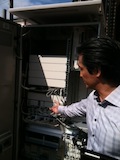
Sprint 4G engineering manager Viet chu shows off a new Alcatel Lucent router for LTE service in Baltimore.
Sprint officials showed off new 4G LTE cellular service today in Baltimore, the carrier's 16th market in the U.S. to get the technology.
Alcatel Lucent routers and other rooftop gear and antennas were recently installed to provision the LTE service in an old brick five-story building in Fell's Point, near the city's Inner Harbor.
Reporters using Samsung Galaxy S III smartphones recorded download speeds at up to 15Mbps and upload speeds at up to 6.5Mbps from the site. Sprint officials said most customers can expect somewhat slower speeds than those in newly activated markets, roughly 6Mbps to 8Mbps for downloads and 2Mbps to 3Mbps for uploads. Those speeds are expected to be consistent at a distance of up to about 1.5 miles from a cell site.
Baltimore is where Sprint launched fast Wimax 4G service in September 2008. Last year, Sprint decided to embrace LTE instead, and is also beefing up its 3G network under an ambitious nationwide multi-year program called Network Vision. Wimax will eventually be phased out, but Wimax devices will be supported through at least 2015, Sprint has said.
Sprint trails both of its bigger competitors, Verizon Wireless and AT&T, in deploying LTE, although it holds one big competitive distinction. "Our key differentiator on LTE is that we still offer unlimited data plans," Viet Chu, manager of 4G engineering for Sprint, said during the cell site tour.
Sprint's approach to LTE means that it will be able to support an array of LTE devices, including an LTE-ready iPhone 5 (or whatever the next-generation device will be called), which Apple is widely expected to announce in September.
Network Vision calls for Sprint to first deploy LTE over the 1.9GHz spectrum it holds, followed by the 2.5GHz spectrum at some point and the 800MHz spectrum later, Chu said. The 1.9GHz channel offers wide geographical coverage, which means Sprint won't need to add more cell sites or towers as additional subscribers buy and use LTE smartphones and other devices, Chu said.
The 2.5GHz channel offers greater LTE capacity, while the 800MHz channel will help with in-building coverage, Chu explained. Wimax was found to have some limits for in-building coverage. "We know that in-building coverage [with Wimax] was a challenge," he said.
Asked what Sprint might do with its unlimited data plans should it suddenly attract plenty of new LTE data hogs that crowd the network and slow down speeds for average users, Chu issued a warning without naming penalties. "If someone abuses the system, we will address it," he said.
Chu declined to say whether those steps might include throttling back LTE speeds, but noted that Sprint doesn't throttle heavy users today.
Sprint doesn't have any formal plans under Network Vision for Wi-Fi offloading of network traffic in busy areas, but Chu said that is one option. Verizon and AT&T are incorporating Wi-Fi hotspots in their coverage plans.
At the Baltimore location shown to reporters, Sprint has kept its Wimax routers in a large, ground-level cabinet, next to a separate new LTE cabinet. Inside the LTE cabinet are several rack-mounted LTE routers from Alcatel Lucent.
The LTE cabinet is connected with fiber optic cables and power cables to three sets of LTE antennas mounted on the roof of the building that houses the Polish National Alliance Club and other tenants.
The antennas, from vendor RFS, are arranged to receive and send data in all directions, and can even be tilted and adjusted remotely, Chu said. Each of the three large antennas has eight different antennas inside, four for receiving signals, four for sending signals under the Multiple Input, Multiple Output design that helps give LTE widespread coverage, Sprint said.
Below each antenna on the roof, Alcatel Lucent has installed a Remote Radio Head (RRH) box, containing circuitry that connects to the ground-level routers. Chu said that older network technologies used to put the RRH box inside or near the cabinet at ground-level, but locating the box near the antenna increases "gain" efficiency, or how well a signal is received.
Sprint is working with LTE equipment suppliers Alcatel-Lucent, Ericsson and Samsung nationally, and recently announced it will work with Alcatel-Lucent and Samsung to provide small cell infrastructure for its network rollouts.
LTE is widely perceived to save network operators costs because it gives greater coverage than older technologies, cutting down on the number of cell sites, towers, antennas and base stations with routers and other gear needed as usage increases. In addition to offering greater in-building coverage, LTE offers lower latency in making connections to the Internet.
Chu maintained that Sprint's networks will allow smooth transitions from LTE to 3G, where needed, compared to Verizon's network architecture.
Asked whether greater LTE network efficiencies might yield lower monthly bills for customers, Chu and other officials laughed. "It means bills might not go up as much," he said.





